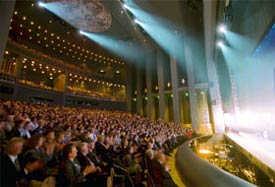The Theory
After our class discussion on Monday, I began thinking about how
people who hope to create awe in others might be able to do so
through an appeal to Jungian archetypes and the collective
unconscious.
Jung defines the unconscious as
"everything of which I know, but of which I am not at the moment
thinking; everything of which I was once conscious but have now
forgotten; everything perceived by my senses, but not noted by my
conscious mind; everything which, involuntarily and without paying
attention to it, I feel, think, remember, want, and do; all the
future things that are taking shape in me and will sometime come to
consciousness: all this is the content of the unconscious" (The
Structure and Dynamics of the Psyche, CW 8, p. 185).
He states that there is a personal unconscious, but also a deeper
collective unconscious:
"In this 'deeper' stratum we also find the . . . archetypes . .
. The instincts and archetypes together form the 'collective
unconscious.' I call it 'collective' because, unlike the personal
unconscious, it is not made up of individual and more or less unique
contents but of those which are universal and of regular occurrence"
(p. 133).
Those archetypes that he mentions are culturally inherited images,
associations, and motifs that we often see in literature and myths
(self, shadow, scapegoat, eternal child, shapeshifter, wise old
man/woman, double, etc.) They are also, according to the Oxford
Dictionary of Critical Theory, ways of thinking and acting that we've
inherited from our distant ancestors.
One of the problems that producers, writers, and artists run into
when trying to create and inspire awe in others is the point of a
diverse audience. We have already discovered in our own class that
the things that inspire some people are only mildly interesting to
others. So, from the perspective of a producer or writer, the Jungian
notion that there is a collective unconscious that connects people
and puts them in a position to be emotionally affected by certain
archetypes or narratives is worth examining.
In Practice
This theory works especially well within +Carly Brown's project about
awe in musicals and my own project about awe in advertising. Both
venues rely heavily on theatricality, narratives, and techniques
intended to elicit emotional responses from an audience.
Songwriters, writers, directors, and producers can play off of
archetypes as common ground within an audience.
Let's take, for example the musical Les Misérables. In this musical
we see examples of the double archetype in Jean Valjean and Javert.
We see the archetype of the Imago Dei in Jean Valjean's conversion
and need for a spiritual center in his life. Jean Valjean also fills
the role of the scapegoat and of the hero. The musical was based on
the book by Victor Hugo, but the fact that these archetypes were
first developed in the book doesn't diminish their power on stage.
When archetypes are used on stage, audiences are able to relax their
guard because they are able to relate to these themes and motifs. The
audience can feel that they are part of the community created by the
theater experience rather than outsiders and spectators looking in
(which, in actuality, they are). When the audience is guarded and
uneasy, it is more difficult for other theatrical elements such as
music, lighting, and staging to inspire that feeling of awe. They
aren't "taken in" by the experience.
The Problems
The collective unconscious and its archetypes certainly help in
making a more universal appeal to audiences and in creating a setting
in which audience can experience awe. However, sometimes even these
appeals to the most universal of archetypes, like the mother in P&G's
recent "Thank you, mom" commercials, can be seen to some as
controversial and exclusive. No amount of music and cinematography
can make up for feelings of exclusion that put the viewer on guard.
I haven't found a theory yet that completely explains how awe is
created and maintained, but Jung's theory of the collective
unconscious and its archetypes seems to be a good start in the
direction of how audiences can be targeted.
Works Cited
McDermott, Dana Sue. "Creativity in the Theater: Robert Edmund
Jones and C. G. Jung." The Margins of Performance. 36:2 (1984).
The Structure and Dynamics of the Psyche (C. G. Jung).


No comments:
Post a Comment